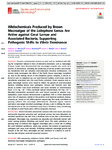Allelochemicals produced by the brown macroalga, Lobophora sp., are active against coral larvae and associated bacteria, supporting pathogenic shifts to Vibrio -dominance
| dc.contributor.author | Morrow, KM | |
| dc.contributor.author | Bromhall, K | |
| dc.contributor.author | Motti, CA | |
| dc.contributor.author | Munn, CB | |
| dc.contributor.author | Bourne, DG | |
| dc.date.accessioned | 2017-05-30T13:49:15Z | |
| dc.date.available | 2017-05-30T13:49:15Z | |
| dc.date.issued | 2017-01 | |
| dc.identifier.issn | 0099-2240 | |
| dc.identifier.issn | 1098-5336 | |
| dc.identifier.other | ARTN e02391-16 | |
| dc.identifier.uri | http://hdl.handle.net/10026.1/9387 | |
| dc.description.abstract |
Pervasive environmental stressors on coral reefs are attributed with shifting the competitive balance in favor of alternative dominants, such as macroalgae. Previous studies have demonstrated that macroalgae compete with corals via a number of mechanisms, including the production of potent primary and secondary metabolites that can influence coral-associated microbial communities. The present study investigates the effects of the Pacific brown macroalga Lobophora sp. (due to the shifting nature of the Lobophora species complex, it will be referred to here as Lobophora sp.) on coral bacterial isolates, coral larvae, and the microbiome associated with the coral Porites cylindrica. Crude aqueous and organic macroalgal extracts were found to inhibit the growth of coral-associated bacteria. Extracts and fractions were also shown to inhibit coral larval settlement and cause mortality at concentrations lower (<0.3 mg · ml−1) than calculated natural concentrations (4.4 mg · ml−1). Microbial communities associated with coral tissues exposed to aqueous (e.g., hydrophilic) crude extracts demonstrated a significant shift to Vibrio dominance and a loss of sequences related to the putative coral bacterial symbiont, Endozoicomonas sp., based on 16S rRNA amplicon sequencing. This study contributes to growing evidence that macroalgal allelochemicals, dissolved organic material, and native macroalgal microbial assemblages all play a role in shifting the microbial equilibrium of the coral holobiont away from a beneficial state, contributing to a decline in coral fitness and a shift in ecosystem structure. IMPORTANCE Diverse microbial communities associate with coral tissues and mucus, providing important protective and nutritional services, but once disturbed, the microbial equilibrium may shift from a beneficial state to one that is detrimental or pathogenic. Macroalgae (e.g., seaweeds) can physically and chemically interact with corals, causing abrasion, bleaching, and overall stress. This study contributes to a growing body of evidence suggesting that macroalgae play a critical role in shifting the coral holobiont equilibrium, which may promote the invasion of opportunistic pathogens and cause coral mortality, facilitating additional macroalgal growth and invasion in the reef. Thus, macroalgae not only contribute to a decline in coral fitness but also influence coral reef ecosystem structure. | |
| dc.format.extent | AEM.02391-16-AEM.02391-16 | |
| dc.format.medium | Electronic-Print | |
| dc.language | en | |
| dc.language.iso | en | |
| dc.publisher | American Society for Microbiology | |
| dc.subject | DNA sequencing | |
| dc.subject | Lobophora | |
| dc.subject | Porites | |
| dc.subject | QIIME | |
| dc.subject | coral larvae | |
| dc.subject | coral reef | |
| dc.subject | holobiont | |
| dc.subject | macroalgae | |
| dc.subject | metagenomics | |
| dc.subject | pathogens | |
| dc.title | Allelochemicals produced by the brown macroalga, Lobophora sp., are active against coral larvae and associated bacteria, supporting pathogenic shifts to Vibrio -dominance | |
| dc.type | journal-article | |
| dc.type | Article | |
| plymouth.author-url | https://www.ncbi.nlm.nih.gov/pubmed/27795310 | |
| plymouth.issue | 1 | |
| plymouth.volume | 83 | |
| plymouth.publication-status | Published online | |
| plymouth.journal | Applied and Environmental Microbiology | |
| dc.identifier.doi | 10.1128/AEM.02391-16 | |
| plymouth.organisational-group | /Plymouth | |
| plymouth.organisational-group | /Plymouth/Research Groups | |
| plymouth.organisational-group | /Plymouth/Research Groups/Marine Institute | |
| dc.publisher.place | United States | |
| dcterms.dateAccepted | 2016-10-07 | |
| dc.identifier.eissn | 1098-5336 | |
| dc.rights.embargoperiod | No embargo | |
| rioxxterms.versionofrecord | 10.1128/AEM.02391-16 | |
| rioxxterms.licenseref.uri | http://www.rioxx.net/licenses/all-rights-reserved | |
| rioxxterms.licenseref.startdate | 2017-01 | |
| rioxxterms.type | Journal Article/Review |


